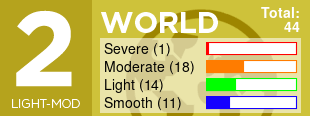About Turbulence Forecast
Published June 06, 2023
Our Turbulence Reporting
Welcome to Turbulence Forecast, and especially to our newest feature! We'll use this blog to explore our work helping nervous and curious flyers take to skies, trends in aviation weather, our own in-flight experiences, and anything else that might be relevant and interesting to those who have found us online.
If you've gotten this far, you likely know that TurbulenceForecast.com offers free maps and tools for projecting turbulence, subscription options to unlock more data, as well as paid reports for individual flights. In this first post, we're going to dig in to how we report for hand-written personalized forecasts with a focus on the scales we use so you can know what to expect. We're focused on what it feels like as a passenger, so while we use some technical language we also try to report to you in a way that is easy to understand and doesn't rely on any prior knowledge of aviation, weather, etc.
There are a few main components to experiencing turbulence as a passenger: frequency, intensity, duration, and type. We talk about each one a bit differently in the reports.
Frequency refers to how often within an area you'll experience bumps. Our job looking at the available data for your report is figuring out when you're likely to feel the bumps. We'll typically define frequency as occasional, on and off, or sustained/consistent. Occasional means moments that are an exception to the prevailing conditions. On and off would be mixed conditions, not necessarily half and half, but often enough that we think occasional would set the wrong expectation. And consistent or sustained is just that, though there can still be some variance.
Intensity often draws the most attention within our forecasts. We define turbulence intensity as light, light to moderate, moderate, moderate to severe, severe, or extreme. With bumpier flights, we know these are the scary words you don't want to see. But what do they mean, and what can you expect? One illustration is that moderate bumps would cause a drink on your tray table to splash within the cup with a few spills over the edge. In lighter conditions, you wouldn't have any spillover; in heavier bumps you would want to take a few sips. Another way of considering this is looking at what's going on in the cabin around you: light bumps will usually mean the seatbelt sign on (in the U.S.), but crew still moving about the cabin as usual for service. Light to moderate will definitely have the seatbelt light on. Moderate bumps and up the pilots will almost always ask the cabin crew to take their seats for safety.
Duration is used two ways: to note segments of a flight and what you can expect in broader areas; and to provide a predicted timeline for any sustained areas we feel need to be highlighted. For example, we might say "on and off light bumps for about two hours, then occasional light for the next hour" or "this area of moderate bumps should clear up after 15-20 minutes." The ranges here account for some variation in flight paths, weather shifts, etc.
Finally, the type of turbulence. On the cruise, we are looking at clear air turbulence (CAT), jet streams, and mountain wave turbulence. The sensation of these is similar as a passenger, usually referred to as chop. Because the feel is similar, we typically don't mention much on the type in our reports unless it is helpful to understand, such as noting the bumps will clear after the Rockies, or that you'll experience some light to moderate entering the jet stream for a tailwind push (and might arrive early). At lower altitudes, we're looking at winds which can cause a slightly different sensation. Headwinds, especially with gusts, feel like going over a wave, or a mini-takeoff. Crosswinds cause more side to side motion.
Most of our flight forecasts will have at least some mention of light bumps at some point, but these are normal and expected. Light to moderate and moderate are common, but usually occur for shorter durations. With moderate and higher, the pilots, controllers, and dispatchers will often work together to try and avoid these areas. No matter what's out there, we're here to help you understand what's coming. Sometimes we err on the side of caution: if the professionals in the cockpit are able to find a better ride, we're happy to hear it. As always, what's most important to remember is that turbulence may be uncomfortable, but it is not unsafe. Commercial aviation remains the safest method of travel. The air is never perfectly still, and aircraft respond to some of that motion, but the fundamentals of flight will not let you down.


